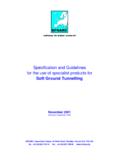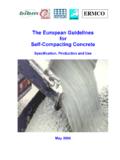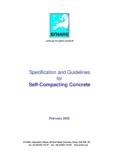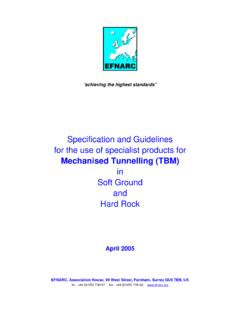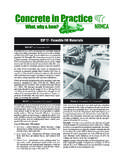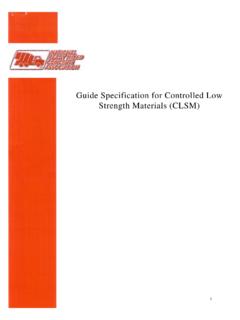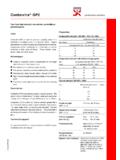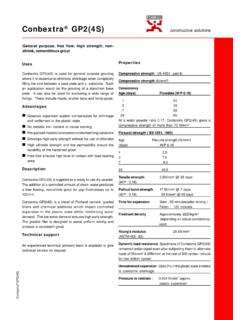Transcription of Guidelines for Viscosity Modifying Admixtures For Concrete
1 'achieving the highest standards' Guidelines for Viscosity Modifying Admixtures For Concrete September 2006 In co-operation with EFCA The European Federation of Concrete Admixture Associations EFNARC Contents 1. 2. 3. 4. Function of a Viscosity Modifying Admixture (VMA)..3 5. Viscosity Modifying Admixtures for Self-Compacting Concrete (SCC)..4 6. Viscosity Modifying Admixtures for Under Water Concrete ..6 7. Viscosity Modifying Admixtures for Pumping 8. Other VMA 9. 10. Annex - Trouble ENC 180 VMA r13, 22/10/06. 1 1. Introduction Concrete is one of the most widely manufactured materials in the world and over recent decades technical innovations, especially in the use of Admixtures have improved not only the quality but also the range of potential applications for this versatile construction product. One of the latest innovations is the development of improved Viscosity Modifying Admixtures (VMA) also referred to as Stabilisers, Viscosity Enhancing Admixtures (VEA) and Water Retaining Admixtures .
2 Water retaining Admixtures are a type of VMA already defined in EN 934-2. Today s Concrete has to fulfil a wide range of requirements in both the fresh and hardened state. In most cases the properties of fresh Concrete also affect the quality of the hardened Concrete and ultimately its durability. This means that Concrete has to be correctly proportioned and must remain homogeneous during placing and after compaction in order to avoid effects such as bleeding, segregation, honey combing, laitance, settlement and plastic cracking over the top bar. These effects would all lead to reduced quality and durability of the hardened Concrete . Modern Concrete technology produces a highly engineered material in which, by the careful selection and proportioning of its constituents, its characteristics have been designed to fulfil specific needs.
3 Modern Concrete allows faster construction, slender structures, greater durability, much higher final strength and faster strength development than was previously possible. Concrete can be pumped both vertically and horizontally over a long distance even with high flow, self compacting properties. The more advanced the Concrete becomes (self-compacting Concrete , high performance Concrete , underwater Concrete , pumpable Concrete , etc.) the more sensitive it gets to material variations and fluctuations during production and placing. Production sites are often faced with problems caused by variations in the moisture content or grading of the aggregates and with fluctuations in the fine content of the sand. Construction sites may face difficulties resulting from the location, access or from breakdowns or other stoppages during placing. Viscosity Modifying Admixtures can be used to produce Concrete with better robustness against the impact of variations in the Concrete constituents and in site conditions, making it easier to control and more friendly for the producer and the user.
4 2. Scope These Guidelines for Viscosity Modifying Admixtures for Concrete represent a practical state-of-the-art document addressed to specifiers, designers, contractors and Concrete producers who wish to enhance their expertise and use of VMA s. The Guidelines covers information for the use of VMA s in selected applications such as SCC, pumped Concrete and underwater Concrete and includes sections on problem solving. 3. References EN 197-1: Cement Part 1: Composition, specification and conformity criteria for common cements EN 206-1: Concrete Part 1: Specification, performance, production and conformity EN 934-2: Admixtures for Concrete , mortar and grout Part 2: Concrete Admixtures EN 12350-2 Testing fresh Concrete Part 2: Slump test EN 12350-8 Testing fresh Concrete Part 8: Slump flow test EN 12350-9 Testing fresh Concrete Part 9: V funnel test ENC 180 VMA r13, 22/10/06.
5 2 The European Guidelines for Self-Compacting Concrete , specification, production and use . (Note: this is available for free download from the web sites of or ) BS 8443 Specification for establishing the suitability of special purpose Concrete Admixtures CUR 18 CUR Aanbeveling 18: Colloidaal beton (Dutch recommendation) 4. Function of a Viscosity Modifying Admixture (VMA) The key function of a VMA is to modify the rheological properties of the cement paste. The rheology of fresh Concrete can be mainly described by its yield point and plastic Viscosity : The yield point describes the force needed to start the Concrete moving. Yield point is related to the workability of the Concrete and may be assessed by tests such as the slump value (EN 12350-2). Plastic Viscosity describes the resistance of a Concrete to flow under external stress. Viscosity is caused by internal friction.
6 The speed of flow of Concrete is related to its plastic Viscosity as shown in the diagram below and may be assessed by the T500 time during a slump flow test (prEN 12350-8) or by the time to flow through a V Funnel (prEN 12350-9). High Viscosity , slow speed of flow Low Viscosity , fast speed of flow The balance between the yield point and the plastic Viscosity is key to obtaining the appropriate Concrete rheology. VMA s change the rheological properties of Concrete by increasing the plastic Viscosity but usually cause only a small increase in the yield point. Admixtures which decrease the yield point are called plasticizers and are often used in conjunction with a VMA to optimise the yield point. VMA s are a family of Admixtures designed for specific applications. They are used to: reduce segregation in highly flowable/self compacting Concrete reduce washout in underwater Concrete reduce friction and pressure in pumped Concrete compensating for poor aggregate grading, especially a lack of fines in the sand reducing powder content in self compacting Concrete reduce bleeding in Concrete improve green strength in semi-dry Concrete ENC 180 VMA r13, 22/10/06.
7 3 Most VMA s are based on high molecular weight polymers with a high affinity to water. By interaction of the functional groups of the molecules with the water and the surfaces of the fines, VMA's build up a three dimensional structure in the liquid phase of the mix to increase the Viscosity and/or yield point of the paste. The strength of the three dimensional structure affects the extent to which the yield point is increased. Some VMA s are based on inorganic materials such as colloidal silica which is amorphous with small insoluble, non-diffusible particles, larger than molecules but small enough to remain suspended in water without settling. By ionic interaction of the silica and calcium from the cement a three dimensional gel is formed which increases the Viscosity and/or yield point of the paste. This three dimensional structure/gel contributes to the control of the rheology of the mix, improving the uniform distribution and suspension of the aggregate particles and so reducing any tendency to bleeding, segregation and settlement.
8 Most VMA s are supplied as a powder blend or are dispersed in a liquid to make dosing easier and improve dosing accuracy. The dosage depends on the application but typically ranges from to by weight of cement but can be varied for specific applications. Most VMA s have little effect on other Concrete properties in either the fresh or hardened state but some if used at high dosage, can affect setting time and or the content and stability of entrained air. Users of VMA s should refer to the admixture manufacturer s data sheet for specific information on recommended dosage and the effect on other properties of the Concrete . 5. Viscosity Modifying Admixtures for Self-Compacting Concrete (SCC) Self-compacting Concrete is a Concrete that is able to flow and consolidate under its own weight, completely fill the formwork even in the presence of dense reinforcement, whilst maintaining homogeneity and without the need for any additional compaction.
9 ENC 180 VMA r13, 22/10/06. 4 Self-compacting Concrete may be classified in three types: the powder type, Viscosity agent type and the combination type: The powder type SCC is characterised by the large amounts of powder (all material < mm) which is usually in the range of 550 to 650 kg/m3. This provides the plastic Viscosity and hence the segregation resistance. The yield point is determined by the addition of superplasticizer. In the Viscosity type SCC the powder content is lower (350 to 450 kg/m3). The segregation resistance is mainly controlled by a VMA and the yield point by the addition of superplasticizer. In the combination type of SCC the powder content is between 450 to 550 kg/m3 but in addition the rheology is also controlled by a VMA as well as an appropriate dosage of the superplasticizer. In a well proportioned SCC the major variation in the composition during production at the plant comes from normal changes in the moisture content of the sand and the coarse aggregates.
10 Variations of % moisture content are typical for aggregate will lead to a change of 10 to 15 litres/m of free water in the Concrete mix. This will lead to significant variations in the flow and cohesion properties of the Concrete being observed from one batch to another on the same day or from one day to another. Viscosity Modifying Admixtures make the Concrete more tolerant to variations in the water content of the mix so that plastic Viscosity is maintained and segregation prevented. The Concrete has become more robust to small but normal changes in the moisture of the aggregate. Viscosity Modifying Admixtures are not a substitute for poor quality constituents or mix design. Aggregates with a good grading curve should always be used for SCC and for high workability Concrete as a lack of fines in aggregates will affect the rheology and may contribute to segregation and settlement. However, where suitable aggregates are not economically available the required rheology of the mix can often be achieved by utilizing a VMA to provide a more homogenous and cohesive Concrete .

